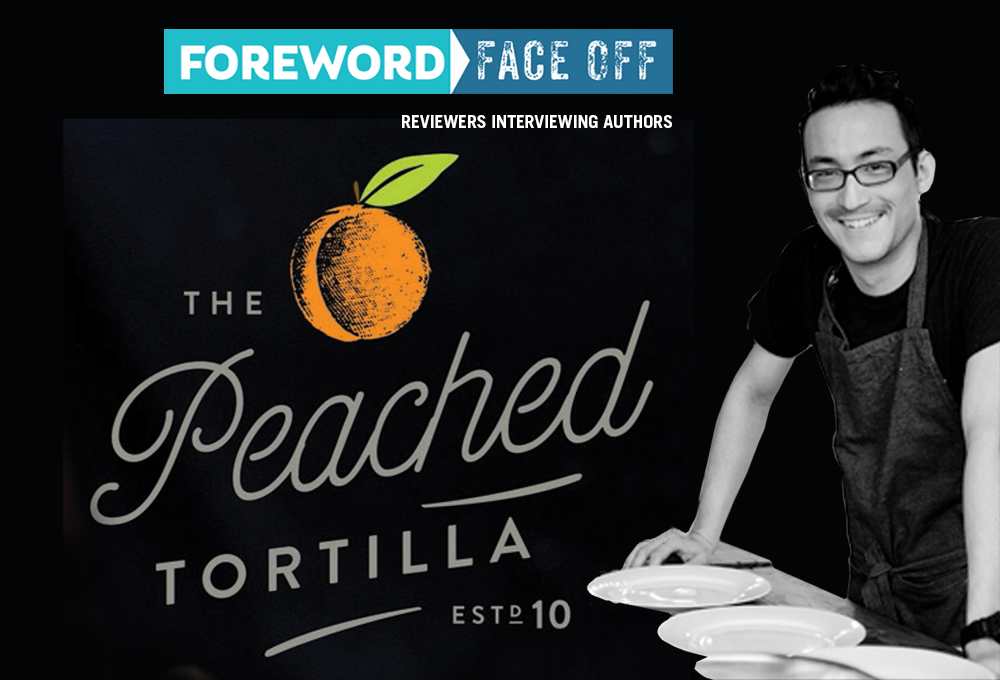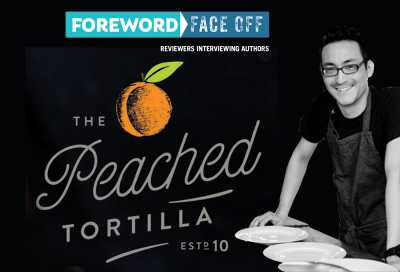Reviewer Rachel Jagareski Talks Kimchi Queso with Eric Silverstein, Author of The Peached Tortilla

Restaurants rock! Find another business that combines such a panoply of pleasures: exquisite food, hip bar scenes, edgy architecture, engaging employees who serve you, and that indefinable special sauce that elevates a dining experience into the stratosphere. Alas, it’s not so easy to do.
Investing a bunch of money in kitchen talent, architecture, wine, and booze is a good start but wannabe restaurateurs be forewarned: any of a dozen other factors can sabotage a restaurant’s success (See: Mario Batali’s #MeToo revelations).
And then there’s the relatively new phenomenon of Yelp and TripAdvisor reviews written by Joe from Kokomo and other off-the-street, opinionated, often snotty—though not trained—diners. We’re in the review business, here at Foreword Reviews, so we sympathize with good restaurants taking undeserved criticism. In any case, that’s the harsh reality of owning a restaurant.

This week, we hear from a chef/restaurateur who’s hardworking, humble, innovative, and beloved by his staff for being such a swell guy. Chinese and Jewish American, Eric Silverstein is also the author of The Peached Tortilla (his restaurant’s name, as well), a cookbook Rachel Jagareski reviewed in our May/June issue of Foreword Reviews.
Smelling a delicious interview, we put Rachel and Eric together with the help of Sterling Epicure. If you ever thought that owning a restaurant looks fun, Eric has some insight for you.
Rachel, take it from here.
Your book is a tasty combination of food memoir and cookbook and reflects a lot of passion and drive. You discuss the highs and lows of starting up your food truck business, then adding the catering component, and finally, opening The Peached Tortilla Restaurant. You state that your work ethic and persistence is what sets you apart in the highly competitive restaurant scene (the boldly flavored and creative food might have something to do with it, too). How do you sustain the grind of such an intense work level over the long haul?
It’s difficult to sustain the grind. When I went on my honeymoon in May 2015, it was the first time I had taken a real vacation since I opened the business in 2010. I’m not one who really enjoys vacations, so it doesn’t bother me so much. But I have a wife who does like vacations, so I need to take time for her.
There are just sacrifices inherent in being a business owner in this industry that you have to mentally accept. Once you accept the fact that you’re never going to have a 9-5 schedule with normal weekends off so long as you own restaurants, you can clear some big mental hurdles and push forward. Everyone’s level of discipline is also very different. You have to be very, very disciplined with your time. I have kids, so I have to be even more rigid with my time. There is just zero time to waste.
The chapters about your food experiences in Japan, travels throughout Asia, and years in Atlanta and Austin are really evocative. Are there any dishes from your large store of diverse food memories that you are experimenting with that might appear on your menu in the near future?
We have a binchotan grill we’re playing around with a lot, so I would imagine some yakitori (chicken skewers bathed in tare, a sweet chicken-infused soy sauce) is in the near future, for sure. I’d love to experiment more with Japanese fast food items—like coming up with a badass teriyaki burger or katsu burger modeled off what I’ve eaten in Japan. I’ve always wanted to perfect tonkatsu (fried Japanese pork cutlet), but was always worried it would be misunderstood and not really sell in the States. And I’d love to recreate a Yoshinoya beef bowl. I could see any of those appearing on the menu in the near future.
One thing that impressed me throughout the book was your ready acknowledgement of the teamwork involved in running your food business. Shots of the smiling faces of your staff at the end of the book and featured at work in various photographs elsewhere are refreshing. How do you attract and maintain staff in an industry where staff turnover is notoriously high?
It’s as simple as showing that you care. But if you’re not around, then how could you possibly care that much? I’ve worked side by side with a lot of my core staff for many years. They’ve seen me put the effort in on food truck shifts when we had a small group of employees. They have seen me grow this thing. I’ve cleaned trucks, washed dishes, and cooked food alongside them. They know that despite all the press and articles, the core culture of the business hasn’t changed. I approach every day exactly the same, with the goal to progress and improve. I really hate taking a step backwards and I refuse to. My staff wants the same thing, so they stick around.
The chapter about pickles and sauces is packed with vibrant recipes and is the largest section in your book. Do you sell these at your restaurant or have any plans for manufacturing and marketing these regionally or nationally in the future?
I thought about selling our Peach BBQ Sauce, but we haven’t gotten around to it yet. We’re currently working with a co-packer for huge batch production that helps supply our location at Austin-Bergstrom Airport. Right now my focus has been more on the restaurant units as opposed to retail products.
What was the last thing you cooked up at home? And what is your all-time favorite comfort-food recipe from the book?
I made Bulgogi recently and also some Lamb Noodles. I also demo’d the Kimchi Queso very recently out of my house. The Southern Fun Noodles is my all-time comfort-food recipe. I have been eating chow fun at home for years, and my mom’s is always better than any chow fun in a restaurant. It’s a dish that not only evokes my mom’s Chinese culture, but just brings me back home.
The well-illustrated Noodle Glossary and Asian Food Glossary appended to your book are so informative and your suggestions about how to use these ingredients are very helpful for home cooks. I’ve been shopping at Asian markets in upstate New York for the last fifteen years but am still unfamiliar with the vast majority of ingredients, so a heartfelt thank you is extended. Are there any Asian ingredients that you are still experimenting with?
I feel like I’m always experimenting with Asian ingredients. I walk in to buy nori and then realize there are 20 different types, and the type of nori that Koreans use is different than the Japanese. So I’ve been working with Korean-style nori recently that is eaten with rice, kimchi, grilled meat, etc. I walk in to buy rice vinegar and then stumble on ten other kinds of vinegar. I’ll sometimes just buy 4 or 5 random ingredients at the Asian store and force myself to use them. I probably have the most fun working through the different types of fresh noodles at Asian grocery stores. I typically will just buy 2 or 3 random packs out of the fridge and start cooking with them.
You certainly don’t glamorize the work of establishing and running a restaurant and are honest about some of the mistakes you made before you became successful. What advice would you offer to people with restaurant dreams?
Humble yourself early on. Understand that it’s a long process and that it’s inevitable that you will make mistakes. Just because you either (1) know how to run a business or (2) can cook, doesn’t mean you are going to be a great restaurant owner. You have to be a jack of all trades. You have to know how to manage people, first and foremost, and build/develop a culture that can evolve and be enriched over time.
You must, unequivocally, understand the numbers associated with your business. If you don’t know where your money is going and which direction it is flowing, you have lost the game before you have even started. And if you want someone else to manage the finances, then you better have 100 percent trust in them and know that they know what they’re doing. Lastly, be prepared to sacrifice. The best business owners are the ones who understand their business but are also willing to make the personal sacrifices necessary to be successful. Ask yourself before you start, what are you willing to give up to be successful? If you’re not willing to give up a lot, I would try something else.
Rachel Jagareski
